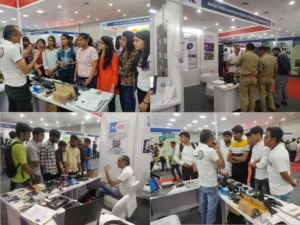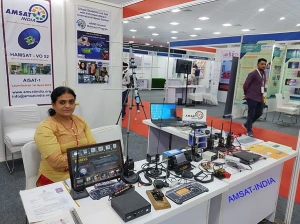-
 AMSAT INDIA, an organisation for
AMSAT INDIA, an organisation forIndian Amateur Radio Satellite Programme .
AMSAT is a worldwide group of Amateur Radio Opertators who share an active interest in building, launching and then communication with each other through non-commercial Amateur Radio satellites.
-
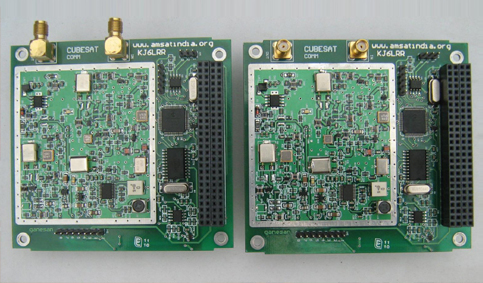 AMSAT INDIA, an organisation for
AMSAT INDIA, an organisation forIndian Amateur Radio Satellite Programme .
AMSAT is a worldwide group of Amateur Radio Opertators who share an active interest in building, launching and then communication with each other through non-commercial Amateur Radio satellites.
-
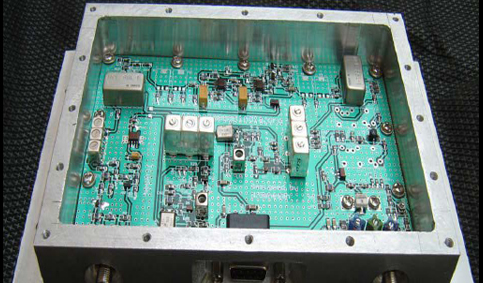 AMSAT INDIA, an organisation for
AMSAT INDIA, an organisation forIndian Amateur Radio Satellite Programme .
AMSAT is a worldwide group of Amateur Radio Opertators who share an active interest in building, launching and then communication with each other through non-commercial Amateur Radio satellites.
AMSAT-INDIA at National Science Day event
To celebrate National Science Day of India on February 28 one of the biggest Science Carnival 2023 was organised by Gujarat state – India at prestigious Science City Ahmadabad during 28th February to 4th March 2023.
AMSAT-INDIA was specially invited to participate in this biggest scientific exhibition for mass awareness on Amateur Radio & Satellite Communication!
AMSAT-INDIA Regional Coordinator Rajesh Vagadia VU2EXP & team member Sakshi Vagadia VU3EXP did huge efforts to mass promote AMSAT activities amongst all sort of visitors which includes young kids, school-college students, budding engineers, IT Programmers, general public, professionals from various industries, scientists from renowned organization like ISRO, PRL, IPR, VSSE, ISR, officers from BSF, Police, Fire dept and citizens from every walk of life! More than 100,000 visitors were reported and grabbed the opportunity to visit science carnival 2023 and our Science exhibition during 5 days.
AMSAT-INDIA stall was spacious & decent sized at 3m x 3m, it was a big attraction at the center of the Science Exhibition. With well prepared different informative Banners on AMSAT-INDIA, Various Satellite Activities, Amateur Radio Satellite chronology, ARISS Student outreach program, ARISS SSTV event, Question submission for our upcoming ARISS student outreach program etc was absolutely eye catching from a distance.
For the curious visitors we tried to highlight every aspect of our hobby and exhibited all sorts of Radio stuff, Documents, QSL Cards, Books, Ham Licence, Awards, Project articles, Tracking software, SSTV software, SDR Software, Cube Satellite models etc to give bit idea of our hobby.
Experiencing various amateur radio gears, satellite antenna & test instruments were highly appreciated by visiting budding engineers from a number of colleges at AMSAT-INDIA stall. Some of the stuff we displayed include; Dual band Arrow-II antenna, dual band Yagi, tape measure antenna, GP, Telescopic antenna for SDR, Radios includes Icom IC-705 with LiFePO4 battery pack, Kenwood VHF base, half dozen of VHF/UHF HTs, RTL-SDR setup, LDG ATU, NanoVNA, Morse Key, cw oscillator, Paddle, electronic keyer, SWR/Power meter, Cable, Connectors etc. It made our task easy to explain the use of each stuff according to the visitors’ query.
We came across various types of queries like how to be a Ham, Procedure to get license, Types of Amateur Radio satellites, operating modes, setting up ground station, how to receive ISS SSTV images, how to establish satellite contact etc. We made a humble attempt to answer & satisfy all of those queries. We enjoyed a very detailed discussion with students/groups who already know about Amateur Radio and always need to learn more on Satellite Communication.
We also highlighted contributions of worldwide AMSAT organizations, IARU, ARISS, RSGB, ARRL and our ARSI & GIAR. I also mark a note on an author and my teacher Mr. Nagendra Vijay of popular Gujarati Science magazine named ‘Scope’ who did tremendous efforts to introduce Ham Radio in Gujarat (India) 40 years back and still continue to create awareness via it’s leading Science magazine ‘Safari’, his stall was just after a row.
AMSAT-INDIA stall were visited by many well-wisher GIAR Ham friends including VU2CPV Pravinbhai, VU2JGI Jagdishbhai, VU2MJP Manojbhai, VU2SPF Bhatnagarji, VU3APY Asheshbhai, VU3VDC Vitthhalbhai, VU3GLY Priyesh, VU3WHO Snehal etc.
It was a great experience for us to spend the whole 5 days enjoying talking & explaining our favorite hobby Amateur Radio & Satellite Communication!
We were happy to present amateur radio as a scientific hobby & experimenting platform for diversified fields and not just emergency communication tools!
Lots of positive & appreciating feedback we received in the visitor feedback book.
We are thankful to Science Carnival 2023 Organiser Dr. Vrajesh Parikh, Pulkesh Prajapati, Dr. Narotam Sahoo & team for inviting us for this prestigious Science Carnival Exhibition. I also thank our AMSAT-INDIA Secretary Mr Nitin Muttin VU3TYG, Director Educational B. A. Subramani VU2WMY, President Ramesh Ramsubbu VU2RMS & committee for complete guidance and support extended to us.
I specially thank team member Sakshi Vagadia VU3EXP & my XYL Kiran Vagadia for supporting and assisting me all the time during the 5 day exhibition.
I am optimistic to see the next generation taking keen interest in Amateur Radio & Satellites from VU Land.
Thank you
73 Rajesh Vagadia VU2EXP
Rajkot – Gujarat
Regional Coordinator West India Zone, AMSAT-INDIA
————————————————————————————————————————————————————————————————————————————–
UPDATES
First signals by r4uab over Russia. R4UAB reported the successful RX of your beacon.

Second signals over Germany by Mike, DK3WN
1:Fm DK3WN To CQ Via AISAT*, [UTC:08:40:12R]
:CQ-0 :TEST DK3WN VIA AISAT-1 congrats 🙂
{102
1:Fm DK3WN To CQ Via AISAT*, [UTC:08:40:25R]
:CQ-0 :TEST DK3WN VIA AISAT-1 congrats 🙂
{103
AISAT launch on April 1, 2019: World’s first innovation to reduce space debris and use rockets more efficiently.
Innovation potentially reduces the cost of satellites by 50%
With the increasing number of satellite launches, there is a need to reduce space debri and to use rocket launch vehicles more efficiently.
ISRO, the Indian Space Research Organisation, has collaborated with AMSAT INDIA, an organization for the Indian amateur radio satellite programme, which in turn has collaborated with Exseed Space, India’s leading private satellite manufacturer, to create a world-first innovation.
ISRO’s PSLV is a proven satellite launch vehicle with four stages. While the first three stages are jettisoned and return to earth, the fourth stage reaches the orbit of 500 km or more and releases its payloads. After the payloads are released, this fourth stage typically becomes space debris, orbiting the earth for a long time till it eventually burns up on re-entry.
ISRO came up with the idea to use this fourth stage as an orbiting platform itself with payloads attached directly to it. In December 2018, ISRO asked AMSAT INDIA to provide an amateur radio payload which would be the first experimental payload in the world to use the fourth stage platform. AMSAT INDIA in turn contracted Exseed Space to design and build this payload.
The resulting satellite: AISAT will be launched at 09:27 IST (03:57 hours UTC) on Monday, April 1 from Sriharikota, India, on PSLV C45.
 |
 |
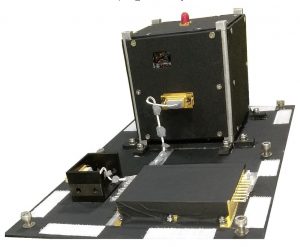 |
The launch marks several world’s -firsts:
• So far, all satellites built have solar panels, power sources and antenna of their own. AISAT, in a world-first, has none of the above systems.
• The satellite uses a shared source of power provided from solar panels on the fourth stage platform and an antenna system provided on the platform by ISRO. This approach makes the payload smaller, lighter and much less expensive to develop a payload.
• As a result of this simplification, AISAT was built from start to finish in a record time of six working days by Exseed Space. Typically, satellites take many months to build this innovation radically brings down the time and cost.
• Typically, over half the mass and half the volume of a satellite is taken up by the solar panels and antenna systems. This innovation reduces the need for both by over 50% – and thus brings down satellite build cost dramatically. This innovation would make space launches among the most affordable in the world.
About the payload:
This experimental radio payload on the fourth stage platform is an Automatic Packet Reporting System (APRS) – also called a digipeater.
APRS is an amateur radio based system for real-time digital communications using a 1200 baud data rate.
APRS data are typically transmitted on a single frequency and repeated locally by area relay stations for widespread dissemination on earth.
In addition, all such data are typically sourced into the APRS Internet System via amateur radio satellite gateway stations located all over the world and distributed globally for ubiquitous and immediate access. APRS digipeater payloads in space, like the one to be launched on April 1, work like terrestrial APRS digipeaters, but with a much larger global footprint.
Use 2019-018AD under tle new
Calling all Radio Hams – Amateur Radio operators:
The frequency used by this payload will be 145.825 MHz in line with other Amateur Radio 1200 bps APRS satellites and the path is via AISAT and also via ARISS (Amateur Radio on International Space Station).
The PSLV C45 launch is scheduled on April 1st 2019 at 09:27 IST or 03:57 UTC
The APRS payload will be powered on at 12:29 IST or 06:59 UTC on April 1, 2019 approximately over 70N Lon and 65E Lat (around Sweden, Norway, Denmark, Finland, Poland, Moscow).
AMSAT INDIA and Exseed Space welcome the amateur radio fraternity around these countries to report the first signals and to make full use of the payload. We also request Radio Hams worldwide to use this payload actively and for satellite gateways to feed APRS traffic.
The team at work
AMSAT INDIA and Exseed Space entered into an agreement where Exseed Space designed and manufactured the payload. The payload was realized in record time – just 6 working days – by the Exseed Space team headed by Ashhar Farhan, VU2ESE.
The payload was extensively tested at URSC-ISRO to undergo thermo-vac, environmental, vibration and EMI/EMC tests. Prior to the above tests improvements at various stages were done at URSC-ISRO to qualify the payload for flight worthiness. These tests and improvements were completed successfully under the guidance of M.R. Raghavendra VU3GTI and B.A.Subramani VU2WMY, who were deputed by ISRO as nodal contacts to work with AMSAT INDIA on this project.
AMSAT INDIA and Exseed Space would like to thank SIPO-ISRO HQ and URSC-ISRO for all the support and encouragement extended in realizing this record-setting project.
Contacts:
For AMSAT INDIA: Ramesh Ramsubbu, vu2rms@gmail.com, +91 9880722553 For Exseed Space: Ashhar Farhan, farhan@exseed.com, +91 98490 26029
Recent Posts
Science Carnival 2023 at Gujarat India
To celebrate National Day of India on February 28 one …AMSAT India at HAMFEST INDIA 2018
HAMFEST INDIA 2018 will be held in the silicon city …Amateur Radio Satellite Activity in India
AO91 and AO92 satellites have created a significant interest among …Organizational Announcements- Regional Co ordinators
We are pleased to announce that as of September 21st …
Be a part of the action and excitement of designing, building and working through the amateur radio satellites.
Sign Up Now!HAMFEST INDIA 2018
HFI 2018 will be held in Bangalore on December 29th and 30th 2018. AI will be setting an exhibition area related to Amateur Radio satellites. Visit www.hamfestindia2018.com for more information.
AMSAT Groups

View Groups
Contact Us
Registered Office:
AMSAT INDIA (Registered)
No. 201, 2nd Main Road,
Mahalakshmi Layout,
Bangalore 560086
India.
Copy 2026 AMSAT INDIA. All Rights Reserved
Web Design and Web Hosting by Nuvodev

